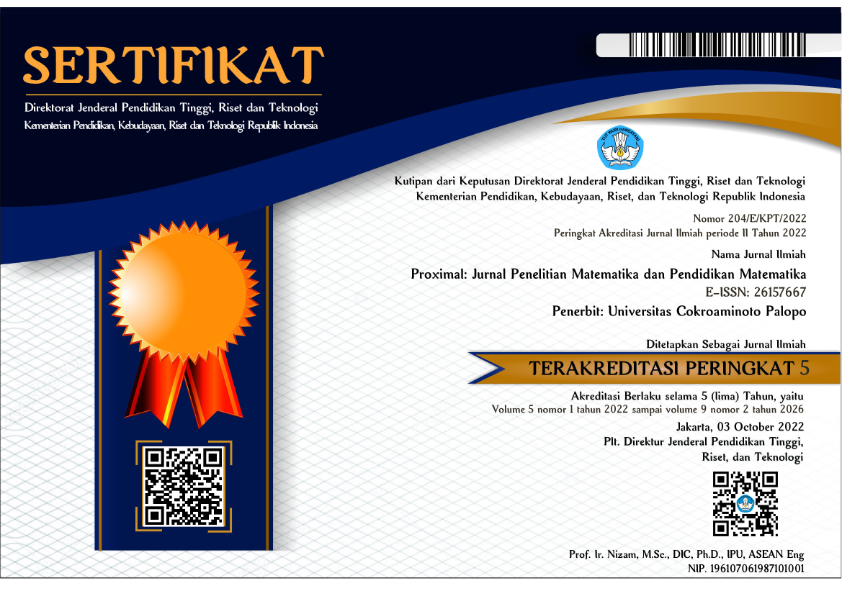EKSPLORASI ETNOMATEMATIKA PADA TRADISI ADAT SESAJI REWANDHA JAWA TENGAH SEBAGAI KONTEKS PEMBELAJARAN UNTUK MENDUKUNG KEMAMPUAN NUMERASI SISWA
DOI:
https://doi.org/10.30605/proximal.v7i2.4121Keywords:
Ethnomathematics, Sesaji Rewandha Tradition, Numeracy SkillsAbstract
This research is an exploratory study to show the relationship between mathematics and culture. This study aims to explore the culture of the traditional activities of the Central Java Rewandha Sesaji tradition which contains mathematical concepts. This research uses ethnographic methods. Data collection techniques use ethnographic principles such as observation, interviews, documentation, and field notes with ethnographic descriptions. The results of the research show that in the traditional activities of the Central Java Rewandha Sesaji tradition there are several mathematical concepts, such as nets and the surface area of a cylinder, the surface area of a cone, the Pythagorean theorem, the area of a circle, the circumference of a circle, parallel lines and quadrilaterals. Several mathematical concepts resulting from the exploration of these traditional traditions can then be used as context in learning to support students' numeracy skills. The results of this research can be used as inspiration for further research to explore other cultural traditions that can be used as a context for realistic mathematics learning that is more fun and meaningful.
Downloads
References
D’Ambrosio, U. (2018). Etnomatemática, justiça social e sustentabilidade. In Estudos Avancados (Vol. 32, Issue 94, pp. 189–204). https://doi.org/10.1590/s0103-40142018.3294.0014
Ekawati, R. (2017). Experts’ notion and students’ responses on context-based mathematics problem. Journal of Engineering Science and Technology, 12(Query date: 2023-01-13 12:00:32), 53–64.
Hubbard, J., & Livy, S. (n.d.). Self-Study of a Mathematics Learning Consultant: Supporting Teachers to Plan Lessons for Implementing Differentiation in the Classroom.
Kohar, A. W., Rahaju, E. B., & Rohim, A. (2022). Prospective teachers’ design of numeracy tasks using a physical distancing context. Journal on Mathematics Education, 13(2), 191–210. https://doi.org/10.22342/jme.v13i2.pp191-210
Kurniawan, H., Purwoko, R. Y., & Setiana, D. S. (2023). Integrating cultural artifacts and tradition from remote regions in developing mathematics lesson plans to enhance mathematical literacy. Journal of Pedagogical Research, 1. https://doi.org/10.33902/JPR.202423016
Leal Vasquez, Ph.D., E. (2017). Ethnomathematics as an Epistemological Booster for investigating Culture and Pedagogical Experience with theYoung Offender orPrison School Communities. Journal of Education and Human Development, 6(1). https://doi.org/10.15640/jehd.v6n2a13
Lopes, C. E., & D’Ambrosio, B. S. (2016). Professional development shaping teacher agency and creative insubordination. Ciência & Educação (Bauru), 22(4), 1085–1095. https://doi.org/10.1590/1516-731320160040015
Muzdalipah, I., & Yulianto, E. (2015). Pengembangan Desain Pembelajaran Matematika untuk Siswa SD Berbasis Aktivitas Budaya dan Permainan Tradisional Msyarakat Kampung Naga. 1(1), 63–74.
Nursyahidah, F., & Albab, I. U. (2021). Learning Design on Surface Area and Volume of Cylinder Using Indonesian Ethno-mathematics of Traditional Cookie maker Assisted by GeoGebra. 13(4).
Nursyahidah, F., Albab, I. U., & Mulyaningrum, E. R. (2023). Learning design of quadrilateral STEM-based through lesson study. Eurasia Journal of Mathematics, Science and Technology Education, 19(11), em2352. https://doi.org/10.29333/ejmste/13747
Nursyahidah, F., Ilma, R., & Somakim, S. (2013). Supporting first grade students’ understanding of addition up to 20 using traditional game. Journal on Mathematics Education, 4(2), 212–223. https://doi.org/10.22342/jme.4.2.557.212-223
Payadnya, I. P. A. A. (2021). Analysis of Students’ Abilities in Solving Realistic Mathematics Problems Using “what-If”-Ethnomathematics Instruments. In Mathematics Teaching-Research Journal (Vol. 13, Issue 4, pp. 131–149).
Prahmana, R. C. I. (2020). Learning geometry and values from patterns: Ethnomathematics on the batik patterns of yogyakarta, indonesia. In Journal on Mathematics Education (Vol. 11, Issue 3, pp. 439–456). https://doi.org/10.22342/jme.11.3.12949.439-456
Prahmana, R. C. I., & D’Ambrosio, U. (2020). Learning Geometry and Values from Patterns: Ethnomathematics on the Batik Patterns of Yogyakarta, Indonesia. Journal on Mathematics Education, 11(3), 439–456. https://doi.org/10.22342/jme.11.3.12949.439-456
Puspadewi, K. R. (n.d.). Etnomatematika di Balik Kerajinan Anyaman Bali. . . ISSN, 4(2).
Shannon, A. G. (2021). Ubiratan D’ambrosio [1932-2021] – ethnomathematics educator for the twenty-first century. International Journal of Mathematical Education in Science and Technology, 52(8), 1139–1142. https://doi.org/10.1080/0020739X.2021.1948629
Siswono, T. Y. E., Kohar, A. W., Hartono, S., Rosyidi, A. H., & Wijayanti, P. (2018). Teachers’ views and experiences on mathematical literacy and context-based task. Proceedings of the International Conference on Science and Technology (ICST 2018). Proceedings of the International Conference on Science and Technology (ICST 2018), Bali, Indonesia. https://doi.org/10.2991/icst-18.2018.166
Suh, J. M., Turner, E., & Anhalt, C. (2019). Exploring the Nature of Mathematics Modeling in the Early Grades. A. G.
Zaenuri, & Dwidayati, N. (2018). Exploring ethnomathematics in Central Java. Journal of Physics: Conference Series, 983, 012108. https://doi.org/10.1088/1742-6596/983/1/012108
Downloads
Published
How to Cite
Issue
Section
License
In submitting the manuscript to the journal, the authors certify that:
- They are authorized by their co-authors to enter into these arrangements.
- The work described has not been formally published before, except in the form of an abstract or as part of a published lecture, review, thesis, or overlay journal.
- That it is not under consideration for publication elsewhere,
- That its publication has been approved by all the author(s) and by the responsible authorities – tacitly or explicitly – of the institutes where the work has been carried out.
- They secure the right to reproduce any material that has already been published or copyrighted elsewhere.
- They agree to the following license and copyright agreement.
License and Copyright Agreement
Authors who publish with this journal agree to the following terms:
- Authors retain copyright and grant the journal right of first publication with the work simultaneously licensed under Creative Commons Attribution License (CC BY 4.0) that allows others to share the work with an acknowledgment of the work's authorship and initial publication in this journal.
- Authors are able to enter into separate, additional contractual arrangements for the non-exclusive distribution of the journal's published version of the work (e.g., post it to an institutional repository or publish it in a book), with an acknowledgment of its initial publication in this journal.
- Authors are permitted and encouraged to post their work online (e.g., in institutional repositories or on their website) prior to and during the submission process, as it can lead to productive exchanges, as well as earlier and greater citation of published work.















